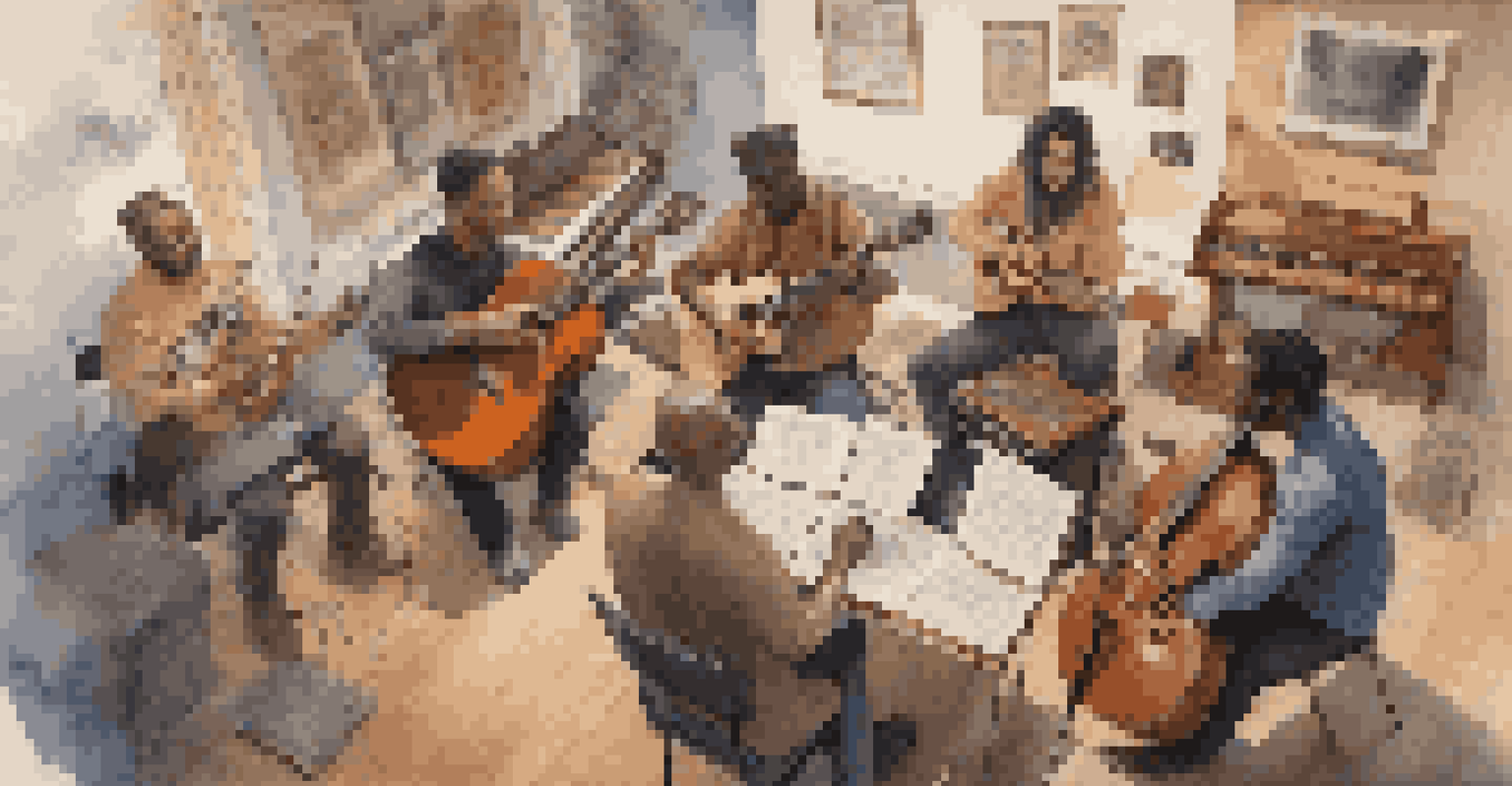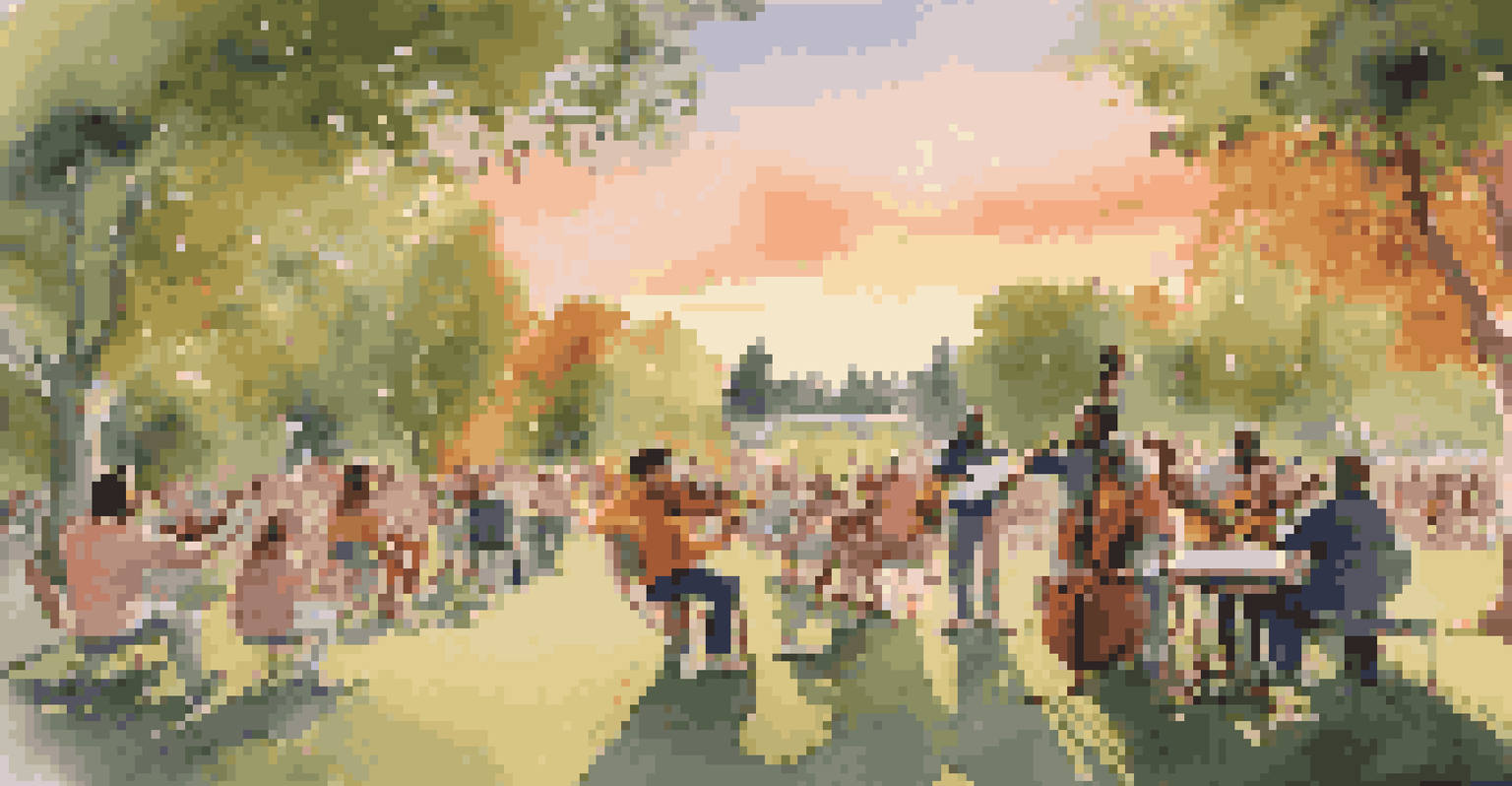The Role of Notation in Collaborative Music Projects: Insights

Understanding Music Notation and Its Importance
Music notation is a system used to visually represent music through symbols. It allows musicians to read, write, and communicate musical ideas effectively. Think of it as a universal language that transcends borders, enabling artists from different backgrounds to collaborate seamlessly.
Music is the shorthand of emotion.
The significance of music notation lies in its ability to provide clarity and structure. For example, when a composer shares sheet music with a band, each musician can interpret their part with precision. This shared understanding is crucial, especially in collaborative projects where diverse talents come together.
Moreover, notation serves as a historical record of musical ideas. By documenting compositions, artists can revisit and refine their work, ensuring that no creative spark is lost. This archival quality of notation fosters a sense of continuity and evolution in collaborative music-making.
Facilitating Communication Among Musicians
Effective communication is at the heart of any successful collaboration, and music notation plays a pivotal role in this process. Musicians can convey complex ideas quickly through written notes, rhythms, and dynamics. This eliminates ambiguity, allowing everyone involved to be on the same page from the get-go.

For instance, imagine a group of musicians jamming together. Without notation, it might be challenging to keep track of changes or variations in the music. However, with simple chord charts, they can easily signal transitions and improvisations, enhancing their collective creativity.
Music Notation: A Universal Language
Music notation serves as a universal language, enabling musicians from diverse backgrounds to collaborate effectively and communicate their musical ideas.
Moreover, notation encourages inclusivity by allowing musicians of varying skill levels to contribute. Beginners can read basic scores while experienced players can elaborate on intricate parts, creating a rich tapestry of sound that reflects the talents of all involved.
Enhancing Creativity Through Structured Frameworks
While music notation provides structure, it also serves as a springboard for creativity. Composers can use notated frameworks to experiment with melodies, harmonies, and rhythms. This structured approach allows artists to push boundaries while still maintaining coherence in their collaborative efforts.
Without music, life would be a mistake.
Consider a scenario where a songwriter provides a basic melody in notation. Other musicians can then add their unique interpretations, whether through improvisation or complementary harmonies. This collaborative layering of ideas can lead to innovative musical outcomes that may not have been possible in isolation.
Furthermore, notation can inspire new directions in a project. When artists see their ideas represented visually, it often sparks fresh perspectives and possibilities, transforming a simple tune into a multifaceted composition that showcases the talents of all contributors.
The Role of Technology in Modern Notation Practices
In the digital age, technology has revolutionized how musicians approach notation. Software like Sibelius or Finale allows for easy creation and sharing of scores, making collaboration more efficient than ever. Musicians can edit and annotate scores in real-time, streamlining the creative process.
Additionally, online platforms enable musicians from different geographical locations to collaborate effortlessly. They can upload their notated pieces, receive feedback, and make adjustments collaboratively, breaking down traditional barriers in music creation.
Enhancing Collaboration with Technology
Modern technology has transformed music notation practices, allowing for real-time collaboration and making it easier for musicians to work together regardless of location.
This technological integration not only enhances collaboration but also democratizes music notation. Aspiring musicians can access resources and tools that were once only available to professionals, fostering a new generation of creative talent in collaborative music projects.
Building Trust Through Notation in Collaborative Projects
Trust is essential in any collaborative endeavor, and music notation can help establish this foundation. By clearly documenting parts and arrangements, musicians can feel confident in their contributions and the overall direction of the project. This transparency fosters a sense of mutual respect among collaborators.
Imagine a scenario where a group of musicians is working on a new album. By using notation, each member can see how their role fits into the larger picture, reducing the likelihood of misunderstandings or conflicts. This clarity empowers everyone to take ownership of their contributions.
Moreover, notation can serve as a reference point for discussions and decision-making. When disagreements arise regarding creative choices, having a written score allows for constructive conversations, ensuring that all voices are heard and valued in the process.
Encouraging Diverse Musical Styles Through Notation
One of the beautiful aspects of music is its diversity, and notation plays a vital role in celebrating this variety. By providing a common language, musicians from different genres can come together to create something unique. For instance, a jazz musician and a classical composer can collaborate using notation to blend their styles.
This intersection of genres often leads to innovative musical fusions that push the boundaries of creativity. When artists understand each other's notations, they can experiment with elements from various styles, enriching their collaborative projects with fresh perspectives.
Fostering Creativity Through Structure
While providing a structured framework, music notation also inspires creativity, allowing musicians to build upon each other’s ideas and explore innovative musical outcomes.
Furthermore, notation can serve as a bridge between traditional and contemporary music. By documenting both classical scores and modern compositions, musicians can explore how different influences can coexist and inspire one another in a collaborative environment.
The Future of Notation in Collaborative Music Projects
As music continues to evolve, so too will the role of notation in collaborative projects. We are likely to see more innovations in digital notation tools that enhance collaboration and creativity. These advancements may include artificial intelligence that assists in composing and arranging music, further transforming how musicians work together.
Additionally, the growing trend of remote collaboration is likely to shape future practices. Musicians may rely even more on notation to bridge the gap between virtual and in-person collaboration, ensuring that creativity knows no bounds.

Ultimately, the future of notation in collaborative music projects looks promising. As artists continue to embrace new technologies and ideas, notation will remain a vital tool for fostering creativity, communication, and connection among musicians worldwide.